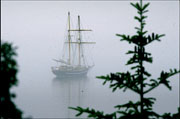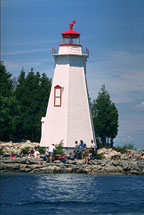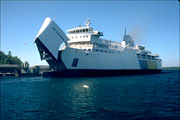Culture and history
Fathom Five National Marine Park
History
Marine History

Tall Ship
© Parks Canada
Shipping around Tobermory began in earnest during the 1850s. Traffic entering Georgian Bay was comprised of schooners from the lower lakes bringing supplies to the developing lumber towns around the Bay. Outbound schooners carried lumber to the growing urban centres of Canada and the United States.

Big Tub Lighthouse
© Parks Canada
The development of improved navigation aids was spurred on by the increasing number of shipwrecks. Three lighthouses were erected in the area: Cove Island in 1858, Big Tub in 1885, and Flowerpot in 1897. As a result of these navigational improvements, and the first complete survey of Georgian Bay completed by Capt. J.G. Boulton in 1888, the frequency of shipwrecks declined.

Cove Island Lighthouse
© Parks Canada
The typical Great Lakes schooner of the 19th century was two- or three-masted and rigged in either a topsail or fore-and-aft configuration. Most were equipped with a large centreboard that reduced drift, added stability and, when raised, allowed entry into shallow harbours. The Canadian-built schooners were usually shorter than the American vessels to enable them to pass through the Welland Canal, which had a maximum lock length of 140 feet (42 m).
By 1890, propeller-driven steamers were rapidly replacing the old schooners. Lumber was still an important commodity, but many of the steamers were coasters, carrying passengers and general wares to the towns and hamlets around Georgian Bay.
For more information about the historic shipwrecks in Fathom Five, see the shipwrecks section of Dive Sites.

Chi Cheemaun
© Parks Canada
The present-day ferry service evolved from those earlier 'package freighters' visiting small ports around the Bay in the days when travel overland was slow and difficult. Early vessels like the Kagawong and Hibou pioneered the service which evolved over the years until today, with the Chi-Cheemaun, the largest vessel of its kind on the Great Lakes. The first ship to run this route for what later became Ontario Northland was the Kagawong, which was only 90 feet (27 m) long, just one-quarter the length of the Chi-Cheemaun. The Chi-Cheemaun, 365 feet (110 m) long, is driven by twin 16-cylinder diesel engines developing 7000 hp which turn two 5-bladed variable pitch propellers which are almost 2.72 metres (9 feet) in diameter.
- Date modified :